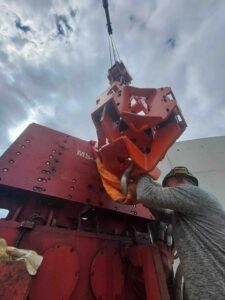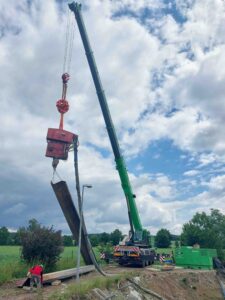Sheet pile walls and their areas of application in groundwork construction
Sheet pile walls are made of sheet piles. They are essential building elements, particularly in special foundation engineering. Sheet pile walls are vertical elements made of steel, wood or plastic that are connected to one another by a special profile to form a tight wall.
Due to their high stability and versatility, sheet pile walls are used in numerous construction projects such as:
Excavation pit protection: protection against landslides and groundwater ingress.
Bank and flood protection: securing river banks, port facilities and dykes.
Deep foundations: stabilizing the subsoil for heavy structures.
Whether in urban areas, on bodies of water or in large-scale construction projects - sheet pile walls ensure safety and efficiency in demanding construction projects.
But which innovations and techniques shape the handling of sheet pile walls today? How can companies in special foundation engineering increase efficiency and sustainability? In this article we provide an insight into the developments and proven procedures.

The choice of material and construction method depends on the project requirements, soil conditions and the environmental conditions. This important work in special foundation engineering requires not only technical expertise, but also the right equipment to protect both machines and the environment. Significant vibrations and noise pollution often occur, especially when ramming or vibration techniques are used to install sheet pile walls.
Modern methods for installing sheet piles
Press-in method:
Use of static pressure to press in the sheet pile.
Advantages: Minimal noise and no vibrations - ideal for urban areas.
Vibro method:
Insertion by vibration with special vibro hammers.
Advantages: High efficiency, especially in soft soils.
Pile driving method:
Use of hydraulic or diesel-powered rams.
Advantages: Speed and high cost-effectiveness.
Challenge: Vibrations and noise pollution for surrounding structures.

Focus on sustainability – How modern sheet pile walls protect the environment
Special foundation engineering helps to find more sustainable solutions. Here are some approaches that have proven successful:
Reusable sheet pile walls: Although expensive to produce, steel sheet pile walls can often be used multiple times, thus reducing material costs and waste.
Innovative materials: Plastic sheet pile walls are becoming increasingly important because they are lighter and more corrosion-resistant.
Reduce emissions: The use of electric or hybrid piling equipment minimizes CO₂ emissions and noise emissions.
Sheet piles are and will remain an essential part of special foundation engineering. With modern processes, sustainable materials and digital technologies, companies can not only increase the efficiency of their projects, but also contribute to more environmentally friendly construction methods. Continuous training and the exchange of best practices are the key to remaining competitive in this demanding field.
Protective measures for telescopic cranes and noise reduction during sheet pile construction
Sheet pile work in special foundation engineering requires not only technical expertise, but also the right equipment to protect people, machines and the environment. Significant vibrations and noise pollution often occur, particularly when telescopic cranes and piling techniques are used. However, these challenges can be effectively solved with modern vibration dampers and innovative protective measures.
Sheet pile work in special foundation engineering requires not only technical expertise, but also the right equipment to protect people, machines and the environment. Significant vibrations and noise pollution often occur, particularly when telescopic cranes and piling techniques are used. However, these challenges can be effectively solved with modern vibration dampers and innovative protective measures.
Challenges of sheet pile installation
Installing sheet piles using vibrators or vibration techniques has many advantages, such as quick installation and high load-bearing capacity. However, these processes generate:
- Significant vibrations that can cause damage to machinery and surrounding structures.
- High levels of noise that affect residents and workers.
- Stresses on telescopic cranes, which must be protected especially during sensitive work.
- Operational efficiency: With minimized vibrations, the crane operates more smoothly, resulting in greater efficiency and less disruption.









The role of vibration dampers
Vibration dampers are crucial to protecting telescopic cranes and other construction equipment from the dangerous effects of vibration. They ensure that:
Mechanical damage is minimized: Without dampers, vibrations can weaken the cranes' joints and support structure over time, leading to expensive repairs or even breakdowns.
Application possibilities are expanded: Thanks to dampers, modern telescopic cranes can also be used when working with vibro hammers or vibrators without affecting their service life.
Safe operation is ensured: By reducing vibrations, the stability of the crane is increased, which means a safety plus for both the operators and the project.
Vibration dampers are available for different crane types and pull-force requirements for implementation in your operations, promising unparalleled protection and performance for sheet pile extraction.
Working in special foundation engineering places high demands on machines and the environment. Through the targeted use of vibration dampers and noise protection measures, companies can make their projects more efficient, safer and more sustainable. These protective measures not only ensure that telescopic cranes remain operational, but also benefit from an extended service life and lower maintenance costs.
